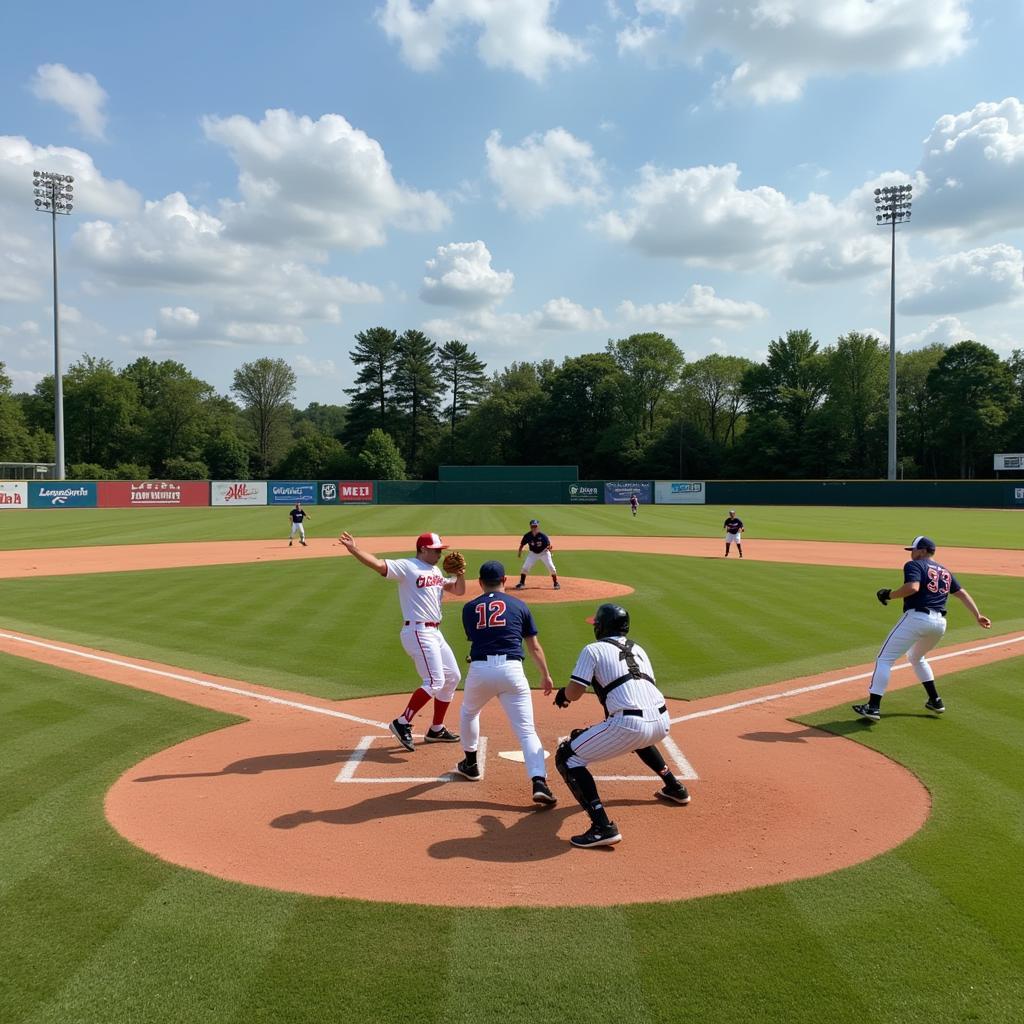Mastering Baseball Defensive Situations
October 21, 2024Baseball is often described as a game of inches, but it’s also a game of wits and split-second decisions. While offensive fireworks might grab the headlines, a strong defense wins championships. Understanding Baseball Defensive Situations is crucial whether you’re a young player, a seasoned veteran, or a passionate fan.
Let’s dive into the core defensive scenarios that define the rhythm and strategy of this beautiful game.
The Fundamentals: Positioning and Communication
Before exploring specific situations, it’s essential to grasp the bedrock of any successful defense: positioning and communication. Every player on the field must understand their role and how it shifts in response to the game’s flow.
Positioning: Each base runner, each out, and even the batter’s tendencies influence where fielders position themselves. A runner on first might prompt a second baseman to hug the bag, while a power hitter could send outfielders back towards the warning track.
Communication: Clear and concise communication is the lifeblood of a strong defense. Fielders constantly adjust their positions based on the game situation, and vocal cues ensure everyone is on the same page, preventing confusion and potential errors.
Common Defensive Situations:
1. Force Outs and Double Plays: Turning Two
A force out occurs when a baserunner is forced to advance to the next base because the batter becomes a runner. This situation presents golden opportunities for double plays, where the defense records two outs in quick succession.
Example: A runner on first base with less than two outs. A ground ball to the shortstop might see him flip the ball to the second baseman (forcing the runner at second) who then throws to first for the second out.
Key Considerations:
- Number of Outs: Double plays are more likely with fewer outs, dictating how aggressively fielders approach ground balls.
- Speed of Runners: A speedy runner on first base might make a double play unlikely, leading to a fielder prioritizing the sure out at first.
2. Bunt Coverage: Defense Against the Small Ball
Bunting is a strategic offensive maneuver where the batter intentionally taps the ball into play, aiming for a base hit or to advance a runner at the expense of an out. Defenses counter with specific bunt coverages.
 Bunt Coverage in Baseball
Bunt Coverage in Baseball
Key Considerations:
- Score Situation: Teams trailing late in the game might employ frequent bunts to scratch across runs, putting pressure on the defense to execute.
- Batter’s History: Some batters are known for their bunting prowess. Defenses adjust accordingly, potentially bringing the third baseman in closer to home plate.
3. Rundowns: A Test of Awareness and Arm Accuracy
A rundown occurs when a baserunner gets caught between bases. This exciting, high-pressure scenario demands quick thinking and precise throws from the defense.
Key Considerations:
- Number of Outs: With two outs, fielders might take more risks in a rundown, attempting to chase down the runner between bases.
- Positioning of Other Runners: The presence of other runners on base can impact the rundown strategy, as fielders must be mindful of potential advancements.
Advanced Defensive Tactics
Beyond the fundamentals, mastering complex defensive situations often involves specialized strategies and plays.
- Shifts: Teams use data and analytics to position their fielders in unconventional spots, increasing the likelihood of recording outs against pull hitters or those with predictable tendencies.
- Pickoff Attempts: Pitchers use pickoff throws to catch runners leaning off base, preventing stolen bases and disrupting the timing of the opposing offense.
- Cutoff and Relay Throws: Long hits to the outfield often require precise cutoff throws to prevent runners from advancing multiple bases. Fielders practice these relays extensively to ensure efficiency and accuracy.
The Mental Game: Anticipation and Focus
Mastering defensive baseball isn’t just about physical skills; it’s about the mental approach. The best defenders are those who can anticipate plays, remain focused under pressure, and communicate effectively with their teammates.
 Baseball Player Focus
Baseball Player Focus
By studying the game, understanding opponent tendencies, and practicing diligently, players can elevate their defensive prowess and contribute significantly to their team’s success.
Conclusion
Baseball defensive situations are a captivating blend of strategy, athleticism, and mental fortitude. Understanding these situations enhances your appreciation for the nuances of the sport, whether you’re on the field or cheering from the stands. Remember, a strong defense isn’t just about preventing runs; it’s about dictating the flow of the game and creating opportunities for offensive success.
FAQs
1. What is the infield fly rule?
The infield fly rule is designed to prevent the defense from intentionally dropping an easy pop fly with runners on base to turn a double play. If there are fewer than two outs and first and second, or first, second, and third base are occupied, the batter is automatically out if they hit a fair fly ball that an infielder can catch with ordinary effort.
2. What is a “wheel play” in baseball?
A “wheel play” is a defensive strategy employed when a runner is on first base and a right-handed batter hits a ground ball towards right field. The second baseman fields the ball and throws to the shortstop covering second base, who then throws to first for a potential double play. This play gets its name from the circular motion of the ball resembling a turning wheel.
3. What is a “Baltimore chop”?
A “Baltimore chop” is a batted ball that hits the ground in front of home plate and takes a high bounce, often over the head of the infielders. This type of hit can result in a base hit, as it gives the batter more time to reach first base before the defense can react.
4. What is a “suicide squeeze play”?
The “suicide squeeze play” is a risky but potentially game-changing offensive strategy. With a runner on third base and less than two outs, the batter attempts a bunt. Simultaneously, the runner on third breaks for home plate on the pitch, hoping to score before the defense can make a play.
5. What are some common defensive mishaps in baseball?
Common defensive errors include:
- Throwing Errors: Inaccurate throws to bases, often resulting in runners advancing.
- Fielding Errors: Mishandling ground balls or fly balls.
- Communication Errors: Misunderstandings between fielders, leading to confusion and missed opportunities.
Need more information on baseball?
Check out these other articles that might be helpful:
Want to know more about Maryland Blue Crabs baseball roster, or find a unique gift for a baseball fan like a wall of baseballs? We’ve got you covered!
We understand you may have more questions about baseball defensive situations. Contact us at Phone Number: 0963418788, Email: [email protected], or visit us at 2M4H+PMH, Nghĩa Thành Ward, Gia Nghĩa, Đắk Nông, Vietnam. Our dedicated customer support team is available 24/7 to assist you.